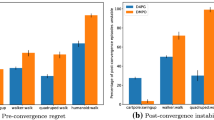Abstract
Answer set programming (ASP) is a knowledge representation and reasoning paradigm with high-level expressive logic-based formalism, and efficient solvers; it is applied to solve hard problems in various domains, such as systems biology, wire routing, and space shuttle control. In this paper, we present an application of ASP to housekeeping robotics. We show how the following problems are addressed using computational methods/tools of ASP: (1) embedding commonsense knowledge automatically extracted from the commonsense knowledge base ConceptNet, into high-level representation, and (2) embedding (continuous) geometric reasoning and temporal reasoning about durations of actions, into (discrete) high-level reasoning. We introduce a planning and monitoring algorithm for safe execution of plans, so that robots can recover from plan failures due to collision with movable objects whose presence and location are not known in advance or due to heavy objects that cannot be lifted alone. Some of the recoveries require collaboration of robots. We illustrate the applicability of ASP on several housekeeping robotics problems, and report on the computational efficiency in terms of CPU time and memory.



Similar content being viewed by others
References
Aker E, Erdogan A, Erdem E, Patoglu V (2011) Causal reasoning for planning and coordination of multiple housekeeping robots. In: Proceedings of LPNMR’11
Aker E, Erdogan A, Erdem E, Patoglu V (2011) Housekeeping with multiple autonomous robots: representation, reasoning and execution. In: Proceedings of commonsense’11
Brewka G, Eiter T, Truszczynski M (2011) Answer set programming at a glance. Commun ACM 54(12):92–103
Bylander T (1994) The computational complexity of propositional STRIPS planning. Artif Intell 69(1–2):165–204
Decker K, Lesser V (1992) Generalizing the partial global planning algorithm. Int J Intell Coop Inf Syst 1:319–346
Eén N, Sörensson N (2003) An extensible sat-solver. In: Proceedings of SAT, pp 502–518
Erdem E, Erdem Y, Erdogan H, Oztok U (2011) Finding answers and generating explanations for complex biomedical queries. In: Proceedings of AAAI
Erdem E, Haspalamutgil K, Palaz C, Patoglu V, Uras T (2011) Combining high-level causal reasoning with low-level geometric reasoning and motion planning for robotic manipulation. In: Proceedings of ICRA
Erdem E, Wong MDF (2004) Rectilinear steiner tree construction using answer set programming. In: Proceedings of ICLP, pp 386–399
Ferrein A, Fritz C, Lakemeyer G (2005) Using GOLOG for deliberation and team coordination in robotic soccer. Künstliche Intelligenz 1
Finin TW, Fritzson R, McKay DP, McEntire R (1994) KQML as an agent communication language. In: Proceedings of CIKM, pp 456–463
Gebser M, Guziolowski C, Ivanchev M, Schaub T, Siegel A, Thiele S, Veber P (2010) Repair and prediction (under inconsistency) in large biological networks with answer set programming. In: Proceedings of KR
Gebser M, Kaminski R, Kaufmann B, Ostrowski M, Schaub T, Thiele S (2008) Engineering an incremental ASP solver. In: Proceedings of ICLP, pp 190–205
Gelfond M, Lifschitz V (1991) Classical negation in logic programs and disjunctive databases. New Gener Comput 9:365–385
Giunchiglia E, Lee J, Lifschitz V, McCain N, Turner H (2004) Nonmonotonic causal theories. Artif Intell 153:49–104
Lavalle SM (1998) Rapidly-exploring random trees: a new tool for path planning. Tech. rep
Lesser V, Decker K, Carver N, Garvey A, Neimen D, Prassad M, Wagner T (1998) Evolution of the GPGP domain independent coordination framework. Tech. rep., University of Massachusetts
Lifschitz V (2008) What is answer set programming? In: Proceedings of AAAI
Liu H, Singh P (2004) ConceptNet: a practical commonsense reasoning toolkit. BT Technol J 22
Lundh R, Karlsson L, Saffiotti A (2008) Autonomous functional configuration of a network robot system. Robot Auton Syst 56(10):819–830
McCain N, Turner H (1997) Causal theories of action and change. In: Proceedings of AAAI/IAAI, pp 460–465
Nogueira M, Balduccini M, Gelfond M, Watson R, Barry M (2001) An a-prolog decision support system for the space shuttle. In: Proceedings of PADL. Springer, Berlin, pp 169–183
O’Brien PRN (1998) FIPA–towards a standard for software agents. BT Technol J 16(3):51–59
Simons P, Niemelä I, Soininen T (2002) Extending and implementing the stable model semantics. Artif Intell 138:181–234
Smith RG (1980) The contract net protocol: high-level communication and control in a distributed problem solver. IEEE Trans Comput 29(12):1104–1113
Tari L, Anwar S, Liang S, Hakenberg J, Baral C (2010) Synthesis of pharmacokinetic pathways through knowledge acquisition and automated reasoning. In: Proceedings of PSB, pp 465–476
Vikrey W (1961) Computer speculation, auctions, and competitive sealed tenders. J Finance 16:8–37
de Weerdt MM, Clement B (2009) Introduction to planning in multiagent systems. Multiagent Grid Syst 5:345–355
Author information
Authors and Affiliations
Corresponding author
Rights and permissions
About this article
Cite this article
Erdem, E., Aker, E. & Patoglu, V. Answer set programming for collaborative housekeeping robotics: representation, reasoning, and execution. Intel Serv Robotics 5, 275–291 (2012). https://doi.org/10.1007/s11370-012-0119-x
Received:
Accepted:
Published:
Issue Date:
DOI: https://doi.org/10.1007/s11370-012-0119-x




